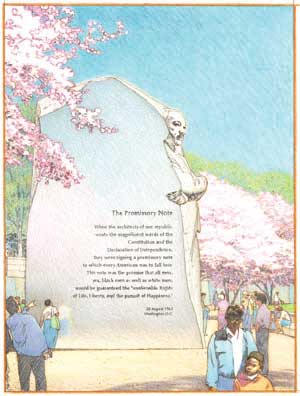|
HOME | SEARCH | ARCHIVE |
|
By Cathy Cockrell, Public Affairs
| |
|
27 SEPTEMBER 00 | An international panel of architects and designers recently announced the winning design for a memorial to Martin Luther King Jr. on the national mall in Washington, D.C.
The jurors - among them Landscape Architecture and Environmental Planning Professor Randy Hester, architecture alumna Laverne Wells-Bowie, and visiting professor Charles Correa - selected a design from ROMA Design Group in San Francisco from among 871 entries from 34 countries.
"The winner is an extraordinarily understated project," Hester says. "It's a long curved wall-like structure that embraces the tidal basin and creates a space that 20 people could be in, or as many as 300 - which seems appropriate for the King Memorial."
The first memorial on the mall to commemorate a black American, it will be located on a four-acre plot near the Roosevelt and Jefferson memorials on the edge of the tidal basin, with a sight line to the Lincoln Memorial, where King gave his famous "I Have a Dream" speech in 1963.
Bonnie Fisher, a principal at ROMA Design who earned her master's in landscape architecture at Berkeley, says the firm's designers, upon learning of the competition, were struck both by the challenge of memorializing such a renowned man and by the nature of the site itself.
Her firm's winning design "was not intended to be a eulogy, to talk about death or enshrinement," Fisher says. "Dr. King said 'death is a comma, not a period.' The approach we were taking was about optimism, hope and the promise of social change."
Those who enter the memorial from Independence Avenue will pass through a stone portal. "The reference in our competition entry is that you are 'hewing out of the mountain of despair a stone of hope,'" she says. "That's from his most famous civil rights' address. We used quite a bit of references to his metaphorical use of language in devising this memorial."
Competition materials called for a design that spoke to "the man, the movement and the message," Hester says. The first time the judges got together, "I felt incredibly weighted down by the responsibility that we had."
The judging process raised "all sort of things that relate to race relations and the civil rights movement and who really should be speaking for it," says Hester, the only white American on the 11-member international panel. "All of the jurors had some particular sense of what it was like during the civil rights movement." To arrive at a decision, he says, the panelists had to navigate "our personal experiences, our racial experiences and disagreements about design philosophy that have nothing to do with race."
The interdisciplinary ROMA team that created the winning design also included team leader Boris Dramov, who has taught studio classes in the College of Environmental Design, and Carl Baker, who earned his undergraduate degree in architecture at Berkeley and developed the scale model for the design.
Home | Search | Archive | About | Contact | More News
Copyright 2000, The Regents of the University of California.
Produced and maintained by the Office of Public Affairs at UC Berkeley.
Comments? E-mail berkeleyan@pa.urel.berkeley.edu.
